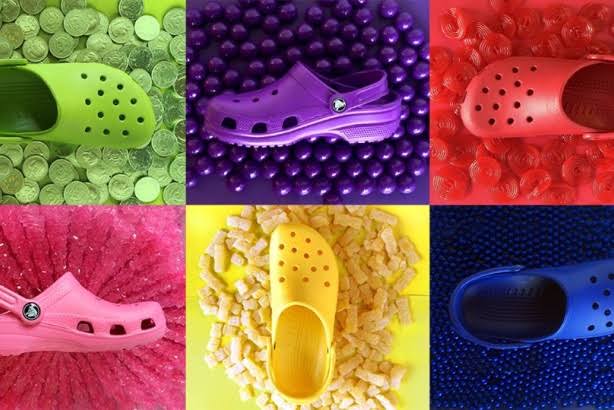👟 Welcome to Crocsy Vibe – Where Comfort Meets Global Style! 🌈
Join Crocs' Recycling Revolution for Sustainability
Join the movement with Crocs’ 'Old Crocs. New Life.' campaign! Discover how Crocs is recycling worn shoes into greener products. Learn about takeback boxes and innovations like recycled Croslite™ f...
SHARAD RAJGURU
7/25/20258 min read


Introduction to Crocs and Sustainability
Founded in 2002, Crocs has evolved from a niche footwear brand into an iconic name in casual footwear, known for its distinctive design and comfort. The brand’s signature clogs, characterized by their lightweight and breathable material, have gained popularity across various demographics and occasions. Amidst this growth, the inevitability of addressing sustainability in fashion has become paramount. With the environmental impacts of the fashion industry under increasing scrutiny, brands like Crocs are recognizing the necessity of integrating sustainable practices in their operations.
As global awareness of environmental issues heightens, there is a growing expectation for brands to take responsibility for their ecological footprint. The footwear industry, in particular, faces significant challenges regarding waste and resource management. Footwear production is resource-intensive, generating large amounts of waste and carbon emissions. Moreover, the materials commonly used in shoes, such as synthetic plastics, contribute to environmental degradation when disposed of improperly. As consumers increasingly demand accountability from brands, the importance of sustainability has surged to the forefront of the fashion narrative.
Crocs has responded to this demand by innovating its practices to align with sustainable trends. The brand is actively exploring eco-friendly materials and technologies that aim to reduce waste and energy consumption during production. Furthermore, research and development into circular economy practices are at the heart of Crocs’ commitment to building a sustainable future. By addressing environmental challenges head-on, Crocs aspires to set an example within the footwear industry, illustrating that it is indeed possible to prioritize comfort and style while also championing sustainability.
The 'Old Crocs. New Life.' Takeback Initiative
In efforts to bolster sustainability practices, Crocs has implemented the 'Old Crocs. New Life.' takeback initiative, a program designed to encourage customers to return their used Crocs footwear. This initiative reflects the brand’s commitment to reducing waste and promoting environmental consciousness among its consumers. Participants in the program are invited to send back their old pairs of Crocs, regardless of their condition. This is an appealing opportunity for environmentally-minded individuals to actively participate in recycling efforts.
Upon returning their used footwear, customers can look forward to receiving some incentives. Each participant is rewarded with a discount on their next purchase, which can be viewed as a win-win situation. Not only do individuals contribute to a larger cause—reducing the environmental impact of footwear production—but they also receive a valuable discount on new products. This approach transforms the act of recycling into a rewarding experience and motivates more customers to engage with sustainability efforts.
The benefits of the 'Old Crocs. New Life.' takeback initiative extend beyond personal incentives. By returning old Crocs, users actively contribute to a circular economy, where materials are reused to create new products rather than ending up in landfills. Crocs aims to repurpose the returned footwear into new materials that can be utilized in various applications, thus minimizing waste and bolstering resource efficiency within their supply chain. This commitment not only strengthens Crocs’ dedication to sustainability but also encourages consumers to rethink their personal role in environmental stewardship.
Ultimately, the 'Old Crocs. New Life.' initiative exemplifies how brands can incentivize recycling and support a more sustainable future. Through its unique takeback program, Crocs is not only repairing its relationship with the planet but also enabling customers to actively participate in positive change.
The Impact of Donating Used Crocs
In recent years, the importance of sustainable practices in the fashion industry has garnered significant attention. One noteworthy initiative within this realm is the donation of gently used Crocs through collaborations with organizations like Soles4Souls. This initiative not only emphasizes the brand’s commitment to sustainability but also contributes significantly to social responsibility. When individuals donate their used Crocs, they provide a pathway for these durable footwear items to find new homes, thereby minimizing waste and extending their life cycle.
Through partnerships with nonprofit organizations, Crocs plays a vital role in supporting community entrepreneurship. For instance, Soles4Souls distributes donated footwear to underserved populations, enabling them to access essential footwear that they might otherwise lack. This act goes beyond mere charitable giving; it empowers individuals by providing them with the opportunities they need to thrive. Entrepreneurs often rely on these donations to resell or distribute the footwear within their communities, thereby creating a sustainable economic model that benefits both the donors and recipients.
The broader implications of such initiatives reflect positively on sustainable fashion. By encouraging customers to recycle, donate, or repurpose their used Crocs, the brand fosters a culture of responsibility and awareness regarding fashion waste. This shift in consumer behavior is essential in combating the overconsumption that plagues the industry. Furthermore, the act of donating Crocs aligns seamlessly with the growing trend of circular fashion, where products are designed to be reused, repurposed, or recycled.
Ultimately, the impact of donating used Crocs reverberates beyond mere environmental benefits. It fosters community ties, supports entrepreneurship, and encourages a responsible approach to consumption. As the fashion landscape continues to evolve, initiatives like these are paramount in nurturing a more sustainable and socially responsible future.
Recycling and Repurposing Unusable Crocs
The increasing concern for environmental sustainability has prompted brands to explore innovative solutions for managing waste products, and Crocs is no exception. When Crocs footwear reaches a point where it is deemed unsuitable for donation, a structured recycling process is implemented to ensure that these items do not contribute to landfills and environmental pollution. This process represents a vital step in promoting a circular economy, where products are designed for longevity and reusability.
The first stage in the recycling of unusable Crocs involves the collection of these items, typically facilitated through dedicated return programs or partnerships with recycling initiatives. Once collected, the Crocs are sorted to identify the materials that can be repurposed. The primary material used in Crocs is Croslite, a proprietary resin that is lightweight and durable. Through specialized recycling techniques, this material can be reprocessed and transformed into pellets, which can then be utilized in the manufacturing of new products.
Repurposed Croslite can be molded into various items, ranging from outdoor furniture to innovative flooring solutions. This not only significantly reduces waste but also conserves resources that would otherwise be expended in the creation of new materials. Furthermore, the recycling process aligns with Crocs' overall sustainability goals, which emphasize responsible consumption and production patterns.
By recycling and repurposing unusable Crocs, the brand not only minimizes its environmental impact but also encourages consumers to adopt sustainable practices. This initiative serves as a significant reminder of the importance of maintaining a circular economy, where the life cycle of products is extended, and waste is systematically reduced. Such efforts exemplify Crocs' commitment to sustainability while also fostering a culture of environmental responsibility among its consumers.
The Role of Customers in Crocs' Sustainability Journey
Customers play a pivotal role in the sustainability journey of Crocs, as their purchasing decisions and behavioral changes significantly influence the company’s approach to environmental responsibility. As consumers become increasingly aware of the environmental issues surrounding waste accumulation, they are taking on the responsibility to seek out brands that promote sustainable practices. Crocs recognizes this shift and actively engages its customers in various sustainability initiatives aimed at reducing its ecological footprint.
One of the most significant ways in which customers can contribute is through participation in Crocs' takeback program. Launched to combat waste, this initiative allows customers to return their old Crocs for recycling or repurposing. By partaking in this program, consumers not only reduce the amount of waste that ends up in landfills but also promote circularity within the fashion industry. Each pair returned can be transformed into new products, illustrating the importance of customer involvement in the recycling process.
Moreover, Crocs fosters community engagement by encouraging customers to share their sustainability stories and experiences. This two-way communication cultivates a sense of connection between the brand and its consumers, inviting them to contribute ideas for new sustainable practices and product designs. Such engagement also helps raise awareness among consumers about the environmental impact of fast fashion, prompting them to consider the lifetime value of their purchases.
In summary, customers are not merely passive recipients of Crocs products; they are active participants in the brand’s sustainability endeavors. Their conscious choices and involvement in initiatives like the takeback program are vital in enabling Crocs to transition towards sustainable practices. As the brand aligns itself with eco-friendly values, the ongoing collaboration with its customer base will be crucial for shaping its future sustainability strategies.
Future Innovations in Sustainable Footwear
The landscape of sustainable footwear is rapidly evolving, with brands like Crocs leading the charge in innovative practices and materials. In an industry marked by increasing consumer awareness regarding environmental concerns, the emphasis on sustainability has become vital. Crocs is actively exploring various sustainable materials, including biodegradable compounds and recycled plastics that can significantly reduce the carbon footprint associated with traditional footwear manufacturing.
Among the discussions surrounding future innovations, Crocs has been investing in alternative materials that not only meet performance standards but also align with eco-friendly principles. For instance, the exploration of new foaming technologies enables the company to produce lightweight, comfortable footwear while simultaneously minimizing reliance on petroleum-based materials. Additionally, advancements in 3D printing technology may allow for more efficient production processes, reducing waste and energy consumption throughout the manufacturing cycle.
Moreover, the footwear industry is undergoing a noticeable shift towards transparency and ethical practices. Many brands now focus on developing circular economy models that prioritize recycling and refurbishment. Crocs’ commitment to this trend aligns with its dedication to creating durable products designed to last, ensuring that the lifecycle of each pair of shoes is extended. With the integration of innovative recycling programs, customers can contribute to sustainable practices by returning worn-out pairs that can be repurposed into new products, thereby reducing landfill waste.
As we look towards the future, continuous improvement in environmental practices will be paramount. By fostering collaborations with research institutions and other sustainable brands, Crocs aims to remain at the forefront of innovations that not only enhance the performance of footwear but also promote environmental integrity. This commitment is not only beneficial for the planet but also meets the increasing expectations of environmentally-conscious consumers, solidifying the brand's position in the sustainable footwear market.
Conclusion: A Greener Path Forward
As we reflect on Crocs' sustainability initiatives, it is clear that the brand is making significant strides in promoting environmental stewardship. From their innovative materials like Croslite, which is not only lightweight but also known for its durability, to their commitment to carbon neutrality by 2030, Crocs is truly embodying a forward-thinking approach to sustainability. The brand has also implemented various recycling programs, encouraging customers to send back their old shoes for proper recycling, thereby reducing waste and extending the product lifecycle.
Furthermore, Crocs has taken steps to source materials responsibly by setting ambitious goals for sustainable sourcing. By using renewable resources and ensuring that their production processes are as eco-friendly as possible, the brand is minimizing its ecological footprint. This commitment is crucial in an era where consumers are increasingly aware of the impact of their purchases on the environment
.As Crocs continues to lead by example, it opens up a dialogue about sustainability across the industry. Companies worldwide can examine the steps Crocs has taken and consider adopting similar practices. Consumers, too, play a vital role in this narrative. By supporting brands that prioritize sustainability, we can collectively drive positive environmental change. Simple choices, such as opting for products made from recycled materials or participating in recycling programs, can significantly contribute to a more sustainable future.
In conclusion, the path forward for Crocs is not just about creating comfortable footwear but also about fostering a sustainable model that benefits the planet. The brand's unwavering dedication to reducing its environmental impact serves as an inspiration for others and highlights the potential for positive change through informed consumer choices. As we move into a new era focused on sustainability, every small action counts, and it is up to us to champion this cause. Together, we can contribute to a greener, healthier world.

Get in touch
Address
3721 Single Street
Quincy, MA 02169
Contacts
123-456-7890
info@email.com
